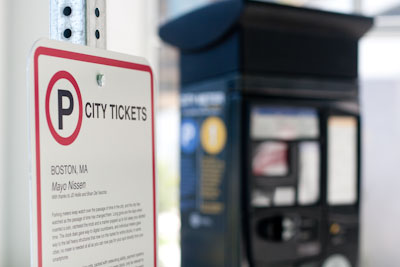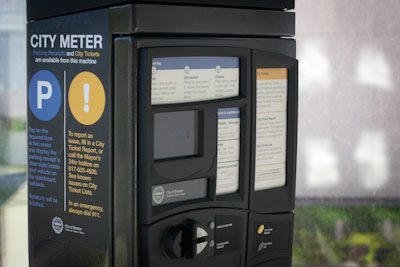Project: City Tickets Boston
Earlier this year I had the opportunity to create the third iteration of my City Tickets project – in Boston, and this time, spitting out real receipts from a real parking terminal, populated by real data from the streets nearby. It’s now less fiction than before.
City Tickets is an exploration into how existing multi-space pay-and-display parking terminals can be used for more than printing slips of paper giving drivers permission to park their cars, and be reframed as a read/write entry point to a citizen responsiveness system such as 311. Originally designed in 2010 for the context of Copenhagen, a New York version was created for the Talk to Me exhibition at New York’s Museum of Modern Art in 2011.
Note: larger versions of the photos below are available on the project page, with links to higher resolution images on flickr

Reprogramming the City at the Boston Society of Architects
Scott Burnham contacted me asking if I would be interested in having the project be part of a show titled Reprogramming the City he was curating at the Boston Society of Architects earlier this year, and had me hooked when he suggested we might be able to get an actual parking terminal from the City of Boston, potentially with the permission to repurpose/hack/reprogram it. I couldn’t resist the temptation not only to bring the concept to a new audience, but to take the project a couple of major steps from design fiction towards design fact.

City Tickets at the Reprogramming the City exhibition, at the Boston Society of Architects
Boston was in many ways a perfect place to take those steps. As well as the Department of Public Works generously lending us an appropriate parking terminal – a spare Parkeon Strada – and being willing to allow us to do to it more or less as we wished, the City also has an extensive civic responsiveness system, and the data from that, sourced from municipal workers, citizen phone calls and text messages, online reports, and use of the Citizens Connect app, openly accessible.

Boston’s parking terminal reframed as a City Meter, with both parking receipts and city tickets available.
Machine and permission to replace most of its working parts acquired, all that remained was to put the plan in action.
I recruited J.D. Hollis, with whom I’ve worked with previously, both at Urbanscale and under our own auspices as near/far, to help get data from the City’s database onto a form ready for birth as thermal-printed tickets coming out of the machine. We worked together with Boston-based Brian Del Vecchio, to whom I had been introduced by our mutual friend Deb Chachra, to get the physical side of the project working: hooking up all the parts, from a mac mini and an off-the-shelf thermal printer, to an Arduino, an LCD screen, and several other components, to the internet and to the machine’s pre-existing buttons, the receipt slot, and getting them all talk to each other and doing their thing in the right order, time after time.
In parallel to the technical challenges, I worked on creating decals to communicate the dual nature of the machine while still feeling Bostonian and fitting into the visual language of the streetscape, and reconfigured the instructional panels on the front of the machine – firstly, to incorporate the city tickets explanations and instructions, and, almost as a side effect, bringing some order and hierarchy to the existing parking-related information (instructions, rates, regulations). All of these graphic changes pulled together the instructional panels with the re-purposed buttons on the front of the machine, with a clear relationship between the parking functionality (blue) and that which belonged with the city tickets (yellow and grey).

Boston’s parking terminal reframed as a City Meter, with both parking receipts and city tickets available.
Working with real data and with the constraints of the hardware in question meant I could gloss over a lot less than I had gotten used to with the Copenhagen and New York “fiction” versions of the project, requiring some rework of the design, especially of the tickets themselves. Thermal printers can only print on one side of a ticket, for starters – something I knew but ignored, and no longer could. Their resolution is stubbornly low – something I had previously mimicked, but now had to fight with. The data pulled from the City’s data store does not always make for convenient line breaks, or have every field complete. Etc, etc.

Reports from the City’s data store, on a city ticket
Thermal printers, and especially the software they come with, are stuck in the dark ages, and getting one pixel to result in a single dot on the paper turned out to be an unexpected challenge. As it was, I redesigned the map tile on the ticket to be legible at even lower resolution than I had originally anticipated.

A city ticket report on the sidewalks of Boston – just waiting for a pothole to report

A citizen suggestion on a city ticket, at an intersection near the exhibition space on Congress Street.
Ironically, the biggest issue with the piece in the context of the show was that the exhibition space was in a nice part of town: not all that much was broken nearby, so the tickets didn’t have a high turnover of interesting issues to report. But that didn’t seem to matter much in the context of the exhibition, or impact people’s understanding of the idea. On the brief occasions I had to linger in the exhibition space, it was gratifying to watch people inspect the description, study the machine, and get it.
There are few things stranger, or more satisfying, than overhearing one exhibition-goer succinctly explain your own project to their companion –
There’s a brain in there. What else could it do?

Proof of sorts that it did, in fact, print a ticket on the press of a button. You’ll have to take my word for it that the data on the ticket was both real and live, and that there isn’t a small monkey inside the machine pushing a ticket through the slot every time. A Boston City Meter – a modified Parkeon Strada machine from the City of Boston – printing a city ticket at the “Reprogramming the City” exhibition at the Boston Society of Architects.
A lovely touch on the part of the curators and organisers was to have, next to the city meter itself, a table with a call for suggestions: what else could these machines do? There was something beautifully meta, with the city meters and city tickets themselves asking for suggestions as to what could be improved in the city itself, and then the exhibition asking how the machines could be put to additional and better use.

What other uses could these machines be put to, what other information could they share with the community?
The newly updated project page is here, with a new set of photos and images from Boston lower down the page as well as full resolution images, for now, on flickr.
← Back to the latest posts
You’re currently reading “Project: City Tickets Boston,” a post by Mayo Nissen
- Published:
- November 11th, 2013
- Filed under:
- citytickets, work

Comments are closed
Comments are currently closed on this entry.